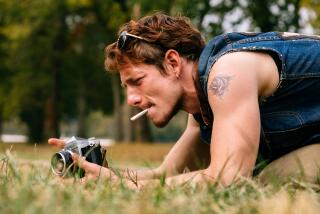Bicycle Lover Wheels--Not Deals--His Classics
- Share via
Leon Dixon, 39, has always loved bicycles, the ones with “fat tires,” as he calls them.
“I used to spend all my time in bicycle shops when I was young,” said Dixon of Huntington Beach, who has perhaps 1,000 bikes stored in small warehouses throughout the county. “I love those bicycles.”
He claims to have to world’s biggest collection of “those bicycles” as well as the largest collection of parts for them. And the largest collection of literature about them.
Many of his bikes are one of a kind, including a fat-tire Charlie Chaplin model.
Dixon refers to the bikes he’s been collecting all his life as “classics” and believes collecting bikes from the 1920 to 1965 era has become the hottest hobby in the last 20 years.
Many of the collectors, he said, are people “who used to own one, or at least wanted to own one.”
Five of Dixon’s bicycles were part of a recent Art of the Machine Age exhibit at the Los Angeles County Museum of Art.
“What I’d really like to get across,” said Dixon, who also collects old cars and electric trains, “is that classic bikes were built for fun. People who owned them enjoyed the way they looked and the way they rode.”
But the thinking has changed. “Now people are buying bicycles that are lightweight, have 10 speeds and skinny tires,” he said. “They’re built for speed and you take them to race tracks. They are serious bicycles.”
He said people who ride speed bikes are not real bicycle people. “They ride them for sport, not for the fun of bike riding or for the fun of the bike itself.
He notes that classic bikes may be more valuable than some antique bikes, those made before 1920.
But he feels it’s a sad commentary on American life that people are only concerned with how much his bicycles are worth.
“That’s not a reason to want something,” he said. “I have a real love for the bikes. When I started collecting them, they weren’t worth anything,” pointing out he’s not wheeling and dealing, just collecting.
He sometimes travels the country for a rare bicycle or parts, a key to bicycle restoration. He remembers once following a bicyclist in his car because the biker had a chain guard he needed. He bought it for $10.
He said metal from classic bikes was used to build fighting equipment for World War II. “Now there’s not that many of them left.”
James C. Harris,) 70, of San Clemente, flew 47 missions over Germany with his B-25 bomber crew during World War II and felt he needed to see them again. It’s been 43 years since the members of the six-man crew went their separate ways.
Harris, the pilot, spent a year tracking them down and recently organized a reunion in Austin. “I wanted to see those guys and see if they have fat bellies and gray hair like I have--and they did,” said Harris, who retired as an Air Force major.
Harris, waist gunner Bob Kucheravy, co-pilot Lew Griffin, tail gunner Jack Cox, top turret gunner John George and bombardier Charles Brown, spent a lot of time retelling war stories they’ve been telling their family and friends.
“We found some of them were in error,” said Harris. “The events were more serious than we thought.”
Kucheravy hadn’t flown for 43 years until he flew to the reunion from Connecticut. “He was on some of the worst missions during the war,” Harris said.
What about another reunion? “Well, we’re all getting old,” said Harris. “We didn’t make any more plans to meet, so. . . . “
Boy Scout Troop 1 in Huntington Beach is the oldest troop in the Orange County Council and the oldest west of the Mississippi.
But it isn’t showing any signs of wear and tear these days. About 300 people showed up for a reunion and to honor the troop on its recent 70th birthday, according to assistant scout master Darrell Rice of Huntington Beach.
“Scouting is in again,” said Rice, who admitted the movement was at a low ebb about seven years ago. “They’re went back to what kids want, and part of that is being outdoors and doing things. It’s the same thing scouts of yesteryear liked.”
He noted that the troop meets weekly in a log cabin built in 1924 by the original scout troop and their fathers. “When the cabin was condemned by the city a number of years back, the scouts of today and their fathers put it back in shape.”
The cabin was declared a historical landmark on the troop’s 50th anniversary.
Acknowledgments--Twin brothers Charles F. and Thomas L. Bosworth, 15, of Mission Viejo, were honored by the Board of Supervisors for attaining the rank of Eagle Scout.
More to Read
Sign up for The Wild
We’ll help you find the best places to hike, bike and run, as well as the perfect silent spots for meditation and yoga.
You may occasionally receive promotional content from the Los Angeles Times.






